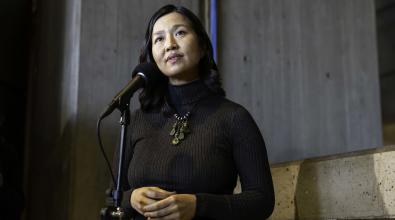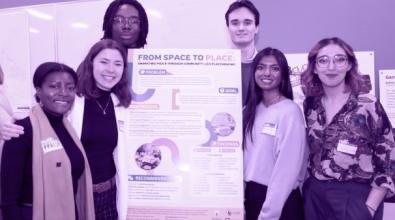 Read More
Read More
This pilot project is shaking things up at public meetings

Listen to This Article
The traditional public meeting—with a classic three-minute-per-speaker format—has been criticized in government innovation circles for years. It allows the squeakiest wheels to dominate. New voices rarely emerge. The feedback comes after key program design decisions have been made. Nonetheless, it persists in cities worldwide.
Now, a promising new intervention—developed by the National Civic League in collaboration with partners such as the Bloomberg Center for Public Innovation and undergoing testing in Boulder, Colo., Fayetteville, N.C., and Mesa, Ariz.—is helping local leaders begin to break the mold to drive meaningful dialogue with residents. Here’s a behind-the-scenes look at this work.
Taking stock of a city’s civic infrastructure.
Who already shows up to public meetings? What networks exist to drive their participation? And who isn’t being heard at all? According to the Civic League’s Matt Leighninger, these are critical questions that many city leaders probably have plenty of anecdotal insight into, but haven’t necessarily mapped out systematically.
That’s why the League offers approaches for what it calls a “civic infrastructure scan,” which is intended to help city leaders identify local engagement capacities—such as volunteer organizations elevating underrepresented voices—and address specific shortfalls, including a failure to integrate new residents into city council meetings.
A test of this approach in Boulder spotlighted encouraging strengths, like a large number of local advocacy and nonprofit groups that already tend to show up at meetings and engage with the city council and mayor. And the city's Community Connectors program encourages diverse communities to get involved through methods such as co-design.
But the scan also revealed a lack of communication between Boulder's diverse communities, which can make it difficult for leaders to build consensus around priorities, and for residents to develop social solidarity. And it showed a frustration that even when residents get a chance to speak at meetings, they don't feel like what they say has a discernible impact on elected officials.
According to Boulder Council Member Matt Benjamin, taking the time to do the scan provided the city “a foundational overview of where we’re at—and it's allowed us to more rapidly sink into some really quick solutions that we can start piloting.”
Infusing innovation into an age-old process.
The Boulder city council plans to experiment with offering the public breakout "study sessions” to weigh in on the substance of new proposals much earlier, in direct dialogue with elected members. While these can’t legally replace mandated “public comment” periods, they can complement those meetings at a time when the chances of influencing the final product are greater. The council is also solidifying plans to hold official meetings in new locations, like at the local university—and also considering venues such as the headquarters of an anti-poverty group with deep ties to the Latino community—to reach a wider range of residents.
Meanwhile, in Mesa, local leaders have just begun rolling out a text-message platform to invite more iterative feedback into school board meetings. Called “Here to Listen,” the system allows residents to submit their own ideas for the board’s consideration, asks them questions about their concerns, and provides a rapid, substantive rundown of what other residents are interested in.
These changes, local leaders believe, can be enacted without violating local public-meeting laws—and, by diversifying and growing the universe of attendees, make it easier for cities to survey participants about how to make city meetings even better.
Tapping into local data capacity.
Once cities do an initial assessment of their public meetings, and then begin experimenting with procedural changes, they can get more ambitious and think about how to deploy innovation muscles to take things to the next level.
That’s what Mesa—which is among 24 cities to achieve Gold Bloomberg Philanthropies What Works Cities Certification for its exceptional use of data, and also recently received support from the Bloomberg Philanthropies Youth Climate Action Fund—is doing to boost youth engagement and, it hopes, enhance public meetings for residents of all ages.
In 2019, Mayor John Giles launched Hactivate, an initiative where high-school students use city datasets to design solutions for local challenges, such as tree-planting to reduce urban heat. Now, the school board is working to replicate that process on its own core issues, like school safety and chronic absenteeism—and to invite students who take part to attend school board meetings, too. The idea is to both generate ideas for the board’s agenda and let students help model the kinds of conversations—substantive and data-driven—that inspire innovation.
These efforts to breathe new life into official public meetings are still underway. But if city leaders succeed, they will have found a way to make meaningful engagement more foundational to how local leaders do business.
As Benjamin, the Boulder council member, put it, “It's incumbent upon us to rise to that moment.”

